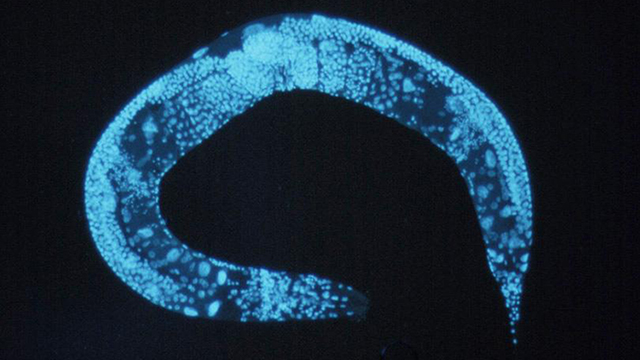October 8, 2019 | Jola Glotzer
Complexities of trait variation
Explained by CBC Awardee, Eric Andersen, NU, in a recent Evolution Letters publication
Congratulations to Erik Andersen, NU for his contributions to a recent publication in Evolution Letters, titled “Tightly linked antagonistic‐effect loci underlie polygenic phenotypic variation in C. elegans.”
In the paper, the authors look into genetics of trait variation using the roundworm Caenorhabditis elegans as a model system. By using experimental genetics, they show that the number of detected genomic variations exceeded that of the observed phenotypic variance. The authors conclude that the underlying reason for the observed discrepancy can be attributed to the antagonistic effect that the mutations located in adjacent intervals of the genome have on each other. In other words, the mutations counteract (or cancel) each other, thus nullifying a phenotypic variance.
Erik Andersen, PhD, is Associate Professor of Molecular Sciences at NU. A CBC Catalyst Award that Andersen received in 2014 for the project “Uncovering ‘Missing Heritability’ in Any Experimentally Tractable Model Organism” partially funded the current study.
Publication attributed to *CBC funding:
Bernstein MR, Zdraljevic S, Andersen EC, Rockman MV. Tightly linked antagonistic‐effect loci underlie polygenic phenotypic variation in C. elegans. Evolution Letters. First published: 11 September 2019. [Epub ahead of print] (doi.org)
ABSTRACT:

Caenorhabditis elegans. (Source: Wikimedia Commons)
Recent work has provided strong empirical support for the classic polygenic model for trait variation. Population‐based findings suggest that most regions of genome harbor variation affecting most traits. Here, we use the approach of experimental genetics to show that, indeed, most genomic regions carry variants with detectable effects on growth and reproduction in Caenorhabditis elegans populations sensitized by nickel stress. Nine of 15 adjacent intervals on the X chromosome, each encompassing ∼0.001 of the genome, have significant effects when tested individually in near‐isogenic lines (NILs). These intervals have effects that are similar in magnitude to those of genome‐wide significant loci that we mapped in a panel of recombinant inbred advanced intercross lines (RIAILs). If NIL‐like effects were randomly distributed across the genome, the RIAILs would exhibit phenotypic variance that far exceeds the observed variance. However, the NIL intervals are arranged in a pattern that significantly reduces phenotypic variance relative to a random arrangement; adjacent intervals antagonize one another, cancelling each other’s effects. Contrary to the expectation of small additive effects, our findings point to large‐effect variants whose effects are masked by epistasis or linkage disequilibrium between alleles of opposing effect.
ACKNOWLEDGMENTS:
This work was supported by NIH R01GM089972 and R01GM121828 (MVR), and funding to ECA from an NIH subcontract (GM107227), the Chicago Biomedical Consortium with support from the Searle Funds at the Chicago Community Trust, and an American Cancer Society Research Scholar Grant (127313‐ RSG‐15‐135‐01‐DD). Support for SZ came from the NIH Cell and Molecular Basis of Disease training grant (T32GM008061). We thank J. Bloom, I. Ruvinsky, T. Turner, and three reviewers for helpful comments. The authors declare no conflicts of interest.
Featured CBC Community member(s):
Erik Andersen, NU
- *CBC Catalyst Award (2014):
▸ Uncovering ‘Missing Heritability’ in Any Experimentally Tractable Model Organism
PIs: Erik Andersen (NU) and Ilya Ruvinsky (NU; at UChicago back then)
ARTICLES PUBLISHED IN THE PAST ABOUT THE FEATURED CBC COMMUNITY MEMBER(S):
June 4, 2019
▸ Understanding genetic diversity
CBC Awardee, Eric Andersen, NU, explains in a recent Genome Research publication
August 29, 2018
▸ 2018 NSF CAREER Award
…goes to past CBC Catalyst recipient, Erik Andersen, NU!

